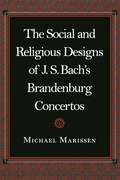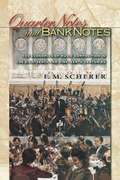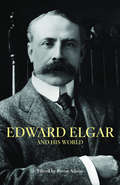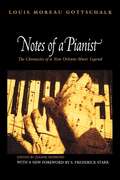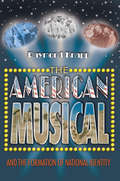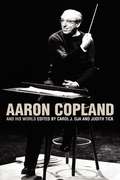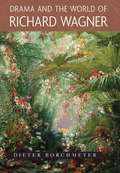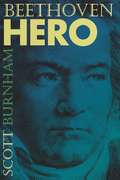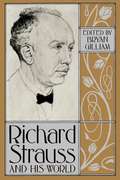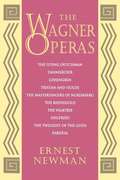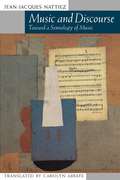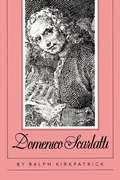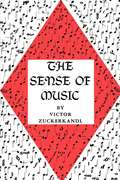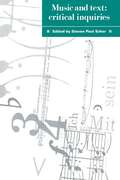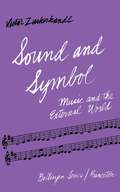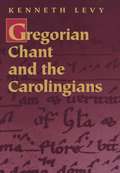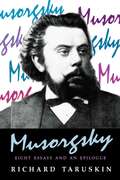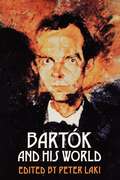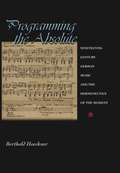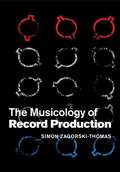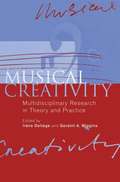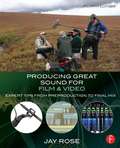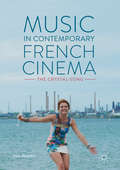- Table View
- List View
The Social and Religious Designs of J. S. Bach's Brandenburg Concertos
by Michael MarissenThis new investigation of the Brandenburg Concertos explores musical, social, and religious implications of Bach's treatment of eighteenth-century musical hierarchies. By reference to contemporary music theory, to alternate notions of the meaning of "concerto," and to various eighteenth-century conventions of form and instrumentation, the book argues that the Brandenburg Concertos are better understood not as an arbitrary collection of unrelated examples of "pure" instrumental music, but rather as a carefully compiled and meaningfully organized set. It shows how Bach's concertos challenge (as opposed to reflect) existing musical and social hierarchies. Careful consideration of Lutheran theology and Bach's documented understanding of it reveals, however, that his music should not be understood to call for progressive political action. One important message of Lutheranism, and, in this interpretation, of Bach's concertos, is that in the next world, the heavenly one, the hierarchies of the present world will no longer be necessary. Bach's music more likely instructs its listeners how to think about and spiritually cope with contemporary hierarchies than how to act upon them. In this sense, contrary to currently accepted views, Bach's concertos share with his extensive output of vocal music for the Lutheran liturgy an essentially religious character.
Quarter Notes and Bank Notes: The Economics of Music Composition in the Eighteenth and Nineteenth Centuries
by F. M. SchererIn 1700, most composers were employees of noble courts or the church. But by the nineteenth century, Chopin, Schumann, Brahms, Verdi, and many others functioned as freelance artists teaching, performing, and selling their compositions in the private marketplace. While some believe that Mozart's career marks a clean break between these two periods, this book tells the story of a more complex and interesting transition. F. M. Scherer first examines the political, intellectual, and economic roots of the shift from patronage to a freelance market. He describes the eighteenth-century cultural "arms race" among noble courts, the spread of private concert halls and opera houses, the increasing attendance of middle-class music lovers, and the founding of conservatories. He analyzes changing trends in how composers acquired their skills and earned their living, examining such impacts as demographic developments and new modes of transportation. The book offers insight into the diversity of composers' economic aspirations, the strategies through which they pursued success, the burgeoning music publishing industry, and the emergence of copyright protection. Scherer concludes by drawing some parallels to the economic state of music composition in our own times. Written by a leading economist with an unusually broad knowledge of music, this fascinating account is directed toward individuals intrigued by the world of classical composers as well as those interested in economic history or the role of money in art.
Edward Elgar and His World
by Byron AdamsEdward Elgar (1857-1934) is undoubtedly one of the most fascinating, important, and influential figures in the history of British music. He rose from humble beginnings and achieved fame with music that to this day is beloved by audiences in England, and his work has secured an enduring legacy worldwide. Leading scholars examine the composer's life in Edward Elgar and His World, presenting a comprehensive portrait of both the man and the age in which he lived. Elgar's achievement is remarkably varied and wide-ranging, from immensely popular works like the famous Pomp and Circumstance March no. 1--a standard feature of American graduations--to sweeping masterpieces like his great oratorio The Dream of Gerontius. The contributors explore Elgar's Catholicism, which put him at odds with the prejudices of Protestant Britain; his glorification of British colonialism; his populist tendencies; his inner life as an inspired autodidact; the aristocratic London drawing rooms where his reputation was made; the class prejudice with which he contended throughout his career; and his anguished reaction to World War I. Published in conjunction with the 2007 Bard Music Festival and the 150th anniversary of Elgar's birth, this elegant and thought-provoking volume illuminates the greatness of this accomplished English composer and brings vividly to life the rich panorama of Victorian and Edwardian Britain. The contributors are Byron Adams, Leon Botstein, Rachel Cowgill, Sophie Fuller, Daniel M. Grimley, Nalini Ghuman Gwynne, Deborah Heckert, Charles Edward McGuire, Matthew Riley, Alison I. Shiel, and Aidan J. Thomson.
Notes of a Pianist
by Louis Moreau Gottschalk Jeanne Behrend Frederick S. StarrNotes of a Pianist chronicles the life of one of the most remarkable musical minds of the American experience, the great nineteenth-century New Orleans-born composer and pianist Louis Moreau Gottschalk (1829-1869). An important cultural and historical work, the book recounts Gottschalk's experiences as he traveled and performed throughout the last decade of his life. Born to an English-Jewish father and a Haitian mother, Gottschalk is remembered as one of the great New Orleans musicians and composers, his music a combination of the classical tradition in which he was trained, and the New Orleans tradition into which he was born. His art form took him far outside the boundaries of Louisiana, however. While still a child, he studied piano in Paris and gave a concert at the Salle Pleyel, after which Frédéric Chopin is said to have remarked: "Give me your hand, my child; I predict that you will become the king of pianists." Gottschalk returned to the United States in 1853, and later lived in Cuba, Puerto Rico, Panama, and South America, during which time he kept-sometimes sporadically, sometimes daily--the notebooks that formed the basis of Notes of a Pianist. Published for the first time in 1881, the book continues to resonate with American cultural and musical life. Notes of a Pianist demonstrates Gottschalk's importance not only as a reporter of the musical life and tastes of Americans during the Civil War, but also as a forefather of Louisiana's rich musical culture.
Listening to Reason: Culture, Subjectivity, and Nineteenth-Century Music
by Michael P. SteinbergThis pathbreaking work reveals the pivotal role of music--musical works and musical culture--in debates about society, self, and culture that forged European modernity through the "long nineteenth century." Michael Steinberg argues that, from the late 1700s to the early 1900s, music not only reflected but also embodied modern subjectivity as it increasingly engaged and criticized old regimes of power, belief, and representation. His purview ranges from Mozart to Mahler, and from the sacred to the secular, including opera as well as symphonic and solo instrumental music. Defining subjectivity as the experience rather than the position of the "I," Steinberg argues that music's embodiment of subjectivity involved its apparent capacity to "listen" to itself, its past, its desires. Nineteenth-century music, in particular music from a north German Protestant sphere, inspired introspection in a way that the music and art of previous periods, notably the Catholic baroque with its emphasis on the visual, did not. The book analyzes musical subjectivity initially from Mozart through Mendelssohn, then seeks it, in its central chapter, in those aspects of Wagner that contradict his own ideological imperialism, before finally uncovering its survival in the post-Wagnerian recovery from musical and other ideologies. Engagingly written yet theoretically sophisticated, Listening to Reason represents a startlingly original corrective to cultural history's long-standing inhibition to engage with music while presenting a powerful alternative vision of the modern.
The American Musical and the Formation of National Identity
by Raymond KnappThe American musical has achieved and maintained relevance to more people in America than any other performance-based art. This thoughtful history of the genre, intended for readers of all stripes, offers probing discussions of how American musicals, especially through their musical numbers, advance themes related to American national identity. Written by a musicologist and supported by a wealth of illustrative audio examples (on the book's website), the book examines key historical antecedents to the musical, including the Gilbert and Sullivan operetta, nineteenth and early twentieth-century American burlesque and vaudeville, Tin Pan Alley, and other song types. It then proceeds thematically, focusing primarily on fifteen mainstream shows from the twentieth century, with discussions of such notable productions as Show Boat (1927), Porgy and Bess (1935), Oklahoma! (1943), West Side Story (1957), Hair (1967), Pacific Overtures (1976), and Assassins (1991). The shows are grouped according to their treatment of themes that include defining America, mythologies, counter-mythologies, race and ethnicity, dealing with World War II, and exoticism. Each chapter concludes with a brief consideration of available scholarship on related subjects; an extensive appendix provides information on each show discussed, including plot summaries and song lists, and a listing of important films, videos, audio recordings, published scores, and libretti associated with each musical.
Aaron Copland and His World (PDF)
by Carol J. Oja Judith TickAaron Copland and His World reassesses the legacy of one of America's best-loved composers at a pivotal moment--as his life and work shift from the realm of personal memory to that of history. This collection of seventeen essays by distinguished scholars of American music explores the stages of cultural change on which Copland's long life (1900 to 1990) unfolded: from the modernist experiments of the 1920s, through the progressive populism of the Great Depression and the urgencies of World War II, to postwar political backlash and the rise of serialism in the 1950s and the cultural turbulence of the 1960s. Continually responding to an ever-changing political and cultural panorama, Copland kept a firm focus on both his private muse and the public he served. No self-absorbed recluse, he was very much a public figure who devoted his career to building support systems to help composers function productively in America. This book critiques Copland's work in these shifting contexts. The topics include Copland's role in shaping an American school of modern dance; his relationship with Leonard Bernstein; his homosexuality, especially as influenced by the writings of André Gide; and explorations of cultural nationalism. Copland's rich correspondence with the composer and critic Arthur Berger, who helped set the parameters of Copland's reception, is published here in its entirety, edited by Wayne Shirley. The contributors include Emily Abrams, Paul Anderson, Elliott Antokoletz, Leon Botstein, Martin Brody, Elizabeth Crist, Morris Dickstein, Lynn Garafola, Melissa de Graaf, Neil Lerner, Gail Levin, Beth Levy, Vivian Perlis, Howard Pollack, and Larry Starr.
Drama and the World of Richard Wagner (PDF)
by Dieter Borchmeyer Daphne EllisRichard Wagner continues to be the most controversial artist in history, a perpetually troubling figure in our cultural consciousness. The unceasing debate over his works and their impact--for and against--is one reason why there has been no genuinely comprehensive modern account of his musical dramas until now. Dieter Borchmeyer's book is the first to present an overall picture of these musical dramas from the standpoint of literary and theatrical history. It extends from the composer's early works--still largely ignored--to the Ring Cycle and Parsifal, and includes Wagner's unfinished works and operas he never set to music. Through lively prose, we come to see Wagner as a librettist--and as a man of letters--rather than primarily as musical composer.Borchmeyer uncovers a vast field of cultural and historical cross-references in Wagner's works. In the first part of the book, he sets out in search of the various archetypal scenes, opening up the composer's dramatic workshop to the reader. He covers all of Wagner's operas, from early juvenilia to the canonical later works.The second part examines Wagner in relation to political figures including King Ludwig II and Bismarck, and, importantly, in light of critical reactions by literary giants--Thomas Mann, whom Borchmeyer calls "a guiding light in this exploration of the fields that Wagner tilled," and Nietzsche, whose appeal to "philology" is a key source of inspiration in attempts to grapple with Wagner's works.For more than twenty years, Borchmeyer has placed his scholarship at the service of the famed Bayreuth Festival. With this volume, he gives us a summation of decades of engagement with the phenomenon of Wagner and, at the same time, the result of an abiding critical passion for his works.
Beethoven Hero (PDF)
by Scott BurnhamBringing together reception history, music analysis and criticism, the history of music theory, and the philosophy of music, Beethoven Hero explores the nature and persistence of Beethoven's heroic style. What have we come to value in this music, asks Scott Burnham, and why do generations of critics and analysts hear it in much the same way? Specifically, what is it that fosters the intensity of listener engagement with the heroic style, the often overwhelming sense of identification with its musical process? Starting with the story of heroic quest heard time and again in the first movement of the Eroica Symphony, Burnham suggests that Beethoven's music matters profoundly to its listeners because it projects an empowering sense of self, destiny, and freedom, while modeling ironic self-consciousness. In addition to thus identifying Beethoven's music as an overarching expression of values central to the age of Goethe and Hegel, the author describes and then critiques the process by which the musical values of the heroic style quickly became the controlling model of compositional logic in Western music criticism and analysis. Apart from its importance for students of Beethoven, this book will appeal to those interested in canon formation in the arts and in music as a cultural, ethical, and emotional force--and to anyone concerned with what we want from music and what music does for us.
Richard Strauss and His World
by Bryan GilliamStrongly influencing European musical life from the 1880s through the First World War and remaining highly productive into the 1940s, Richard Strauss enjoyed a remarkable career in a constantly changing artistic and political climate. This volume presents six original essays on Strauss's musical works--including tone poems, lieder, and operas--and brings together letters, memoirs, and criticism from various periods of the composer's life. Many of these materials appear in English for the first time. In the essays Leon Botstein contradicts the notion of the composer's stylistic "about face" after Elektra; Derrick Puffett reinforces the argument for Strauss's artistic consistency by tracing in the tone poems and operas the phenomenon of pitch specificity; James Hepokoski establishes Strauss as an early modernist in an examination of Macbeth; Michael Steinberg probes the composer's political sensibility as expressed in the 1930s through his music and use of such texts as Friedenstag and Daphne; Bryan Gilliam discusses the genesis of both the text and the music in the final scene of Daphne; Timothy Jackson in his thorough source study argues for a new addition to the so-called Four Last Songs. Among the correspondence are previously untranslated letters between Strauss and his post-Hofmannsthal librettist, Joseph Gregor. The memoirs range from early biographical sketches to Rudolf Hartmann's moving account of his last visit with Strauss shortly before the composer's death. Critical reviews include recently translated essays by Theodor Adorno, Guido Adler, Paul Bekker, and Julius Korngold.
The Wagner Operas
by Ernest NewmanIn this classic guide, the foremost Wagner expert of our century discusses ten of Wagner's most beloved operas, illuminates their key themes and the myths and literary sources behind the librettos, and demonstrates how the composer's style changed from work to work. Acclaimed as the most complete and intellectually satisfying analysis of the Wagner operas, the book has met with unreserved enthusiasm from specialist and casual music lover alike. Here, available for the first time in a single paperback volume, is the perfect companion for listening to, or attending, The Flying Dutchman, Tannhäuser, Lohengrin, Tristan and Isolde, Die Meistersinger, the four operas of the Ring Cycle, and Parsifal. Newman enriches his treatment of the stories, texts, and music of the operas with biographical and historical materials from the store of knowledge that he acquired while completing his numerous books on Wagner, including the magisterial Life of Richard Wagner. The text of The Wagner Operas is filled with hundreds of musical examples from the scores, and all the important leitmotifs and their interrelationships are made clear in Newman's lucid prose. "This is as fine an introduction as any ever written about a major composer's masterpieces. Newman outlines with unfailing clarity and astuteness each opera's dramatic sources, and he takes the student through the completed opera, step by step, with all manner of incidental insight along the way."--Robert Bailey, New York University
Music and Discourse: Toward a Semiology of Music
by Jean-Jacques Nattiez Carolyn AbbateIn this book Jean-Jacques Nattiez, well-known for his pioneering work in musical semiology, examines both music, and discourse about music, as products of human activity that are perceived in varying ways by various cultures. Asking such questions as "what is a musical work" and "what constitutes music," Nattiez draws from philosophy, anthropology, music analysis, and history to propose a global theory for the interpretation of specific pieces, the phenomenon of music, and the human behaviors that music elicits. He reviews issues raised by the notion of the musical sign, and shows how Peircian semiotics, with its image of a chain or web of meanings, applies to a consideration of music's infinite and unstable potential for embodying meaning. In exploring the process of ascribing meaning to music, Nattiez reviews writings on the psychology of music, non-Western metaphorical descriptions, music-analytical prose, and writings in the history of musical aesthetics. A final analytical chapter on the Tristan chord suggests that interpretations of music are cast in terms of analytical plots shaped by transcendent principles, and that any semiological consideration of music must account for these interpretive narratives.
Domenico Scarlatti (PDF)
by Ralph KirkpatrickAgain available in paperback, this definitive work on the genius of Domenico Scarlatti (1685-1757) is the result of twelve years of devoted effort by America's foremost harpsichordist and one of the principal authorities on eighteenth-century harpsichord music. Mr. Kirkpatrick traveled extensively to collect material that has tripled the known facts about Scarlatti's life, providing the first adequate biography of one of the greatest harpsichord composers of the eighteenth century and one of the most original composers of all time. The second half of his book is an illuminating study of Scarlatti's 555 sonatas, concluding with a chapter on their performance. The book contains extensive appendixes, including discussions of ornamentation and Scarlatti's vocal music, and an updated section of addenda and corrigenda.
The Sense of Music
by Victor ZuckerkandlThis book is addressed to the listener whose enjoyment of music is filled with questions and whose curiosity makes him eager to grasp the sense of music, despite a lack of theoretical training. Unlike the usual listener's guide, which begins with a discussion of the elementary materials of music, this book starts with the elementary experiences of listening.
Music And Text: Critical Inquiries (PDF)
by Steven Paul ScherMelopoetics, the study of the multifarious relations between music and literature, has emerged in recent years as an increasingly popular field of interdisciplinary inquiry. In this volume, noted musicologists and literary critics explore diverse topics of shared concern such as literary theory as a model for musical criticism, genre theories in literature and music, the criticism and analysis of texted music and the role of aesthetic, historical and cultural understanding in concepts of text/music convergence. These fourteen essays - united here not by a common ideology but by common subject matter - demonstrate how musical and literary scholarship can combine forces effectively on the common ground of contemporary critical theory and interpretive practice. The concluding essay by interdisciplinary historian Hayden White locates this ambitious enterprise of contemplating 'music and text' in the larger context of intellectual history.
Sound and Symbol, Volume 1: Music and the External World
by Victor Zuckerkandl Willard R. TraskAn approach to music as an instrument of philosophical inquiry, seeking not so much a philosophy of music as a philosophy through music.
Gregorian Chant and the Carolingians
by Kenneth LevyA world-renowned scholar of plainchant, Kenneth Levy has spent a portion of his career investigating the nature and ramifications of this repertory's shift from an oral tradition to the written versions dating to the tenth century. In Gregorian Chant and the Carolingians, which represents the culmination of his research, Levy seeks to change long-held perceptions about certain crucial stages of the evolution and dissemination of the old corpus of plainchant--most notably the assumption that such a large and complex repertory could have become and remained fixed for over a century while still an oral tradition. Levy portrays the promulgation of an authoritative body of plainchant during the reign of Charlemagne by clearly differentiating between actual evidence, hypotheses, and received ideas. How many traditions of oral chant existed before the tenth century? Among the variations noted in written chant, can one point to a single version as being older or more authentic than the others? What precursors might there have been to the notational system used in all the surviving manuscripts, where the notational system seems fully formed and mature? In answering questions that have long vexed many scholars of Gregorian chant's early history, Levy offers fresh explanations of such topics as the origin of Latin neumes, the shifting relationships between memory and early notations, and the puzzling differences among the first surviving neume-species from the tenth century, which have until now impeded a critical restoration of the Carolingian musical forms.
Musorgsky: Eight Essays and an Epilogue
by Richard Taruskin"It is [a] fully illuminated story that Richard Taruskin, in the path-breaking essays collected here, unfolds around Modest Musorgsky, Russia's greatest national composer.... [Taruskin's] tour de force comes with a frontal attack on all the Soviet-bred truisms that for a century have refashioned Musorgsky from what the evidence suggests he was--an aristocrat with an early clinical interest in true-to-life musical portraiture and a later penchant for drinking partners who were both folklore buffs and political reactionaries democrat."--From the foreword Incorporating both new and now-classic essays, this book for the first time sets the vocal works of Modest Musorgsky in a fully detailed cultural, political, and historical context. From this perspective Richard Taruskin revises fundamentally the composer's historical and artistic image, in particular debunking the century-old dogmas of Vladimir Stasov, Musorgsky's first biographer. Here the author offers the most complete explanation of the revision of the opera Boris Godunov, compares it to contemporaneous operas by Chaikovsky and Rimsky-Korsakov, advances a revisionary characterization of Khovanshchina as an aristocratic tragedy informed by a pessimistic view of history, discusses Musorgsky's use of folklore, and, focusing on Sorochintsi Fair, brings to a climax his refutation of Musorgsky as a protorevolutionary populist. The epilogue is a survey of revisionary productions of Musorgsky's works at home during the Gorbachev era.
Bartók and His World (PDF)
by Peter LakiBéla Bartók, who died in New York fifty years ago this September, is one of the most frequently performed twentieth-century composers. He is also the subject of a rapidly growing critical and analytical literature. Bartók was born in Hungary and made his home there for all but his last five years, when he resided in the United States. As a result, many aspects of his life and work have been accessible only to readers of Hungarian. The main goal of this volume is to provide English-speaking audiences with new insights into the life and reception of this musician, especially in Hungary. Part I begins with an essay by Leon Botstein that places Bartók in a large historical and cultural context. László Somfai reports on the catalog of Bartók's works that is currently in progress. Peter Laki shows the extremes of the composer's reception in Hungary, while Tibor Tallián surveys the often mixed reviews from the American years. The essays of Carl Leafstedt and Vera Lampert deal with his librettists Béla Balázs and Melchior Lengyel respectively. David Schneider addresses the artistic relationship between Bartók and Stravinsky. Most of the letters and interviews in Part II concern Bartók's travels and emigration as they reflected on his personal life and artistic evolution. Part III presents early critical assessments of Bartók's work as well as literary and poetic responses to his music and personality.
Programming the Absolute: Nineteenth-Century German Music and the Hermeneutics of the Moment
by Berthold HoecknerProgramming the Absolute discusses the notorious opposition between absolute and program music as a true dialectic that lies at the heart of nineteenth-century German music. Beginning with Beethoven, Berthold Hoeckner traces the aesthetic problem of musical meaning in works by Schumann, Wagner, Liszt, Mahler, and Schoenberg, whose private messages and public predicaments are emblematic for the cultural legacy of this rich repertory. After Romanticism had elevated music as a language "beyond" language, the ineffable spurred an unprecedented proliferation of musical analysis and criticism. Taking his cue from Adorno, Hoeckner develops the idea of a "hermeneutics of a moment," which holds that musical meaning crystallizes only momentarily--in a particular passage, a progression, even a single note. And such moments can signify as little as a fleeting personal memory or as much as the whole of German music. Although absolute music emerged with a matrix of values--the integrity of the subject, the aesthetic autonomy of art, and the intrinsic worth of high culture--that are highly contested in musicology today, Hoeckner argues that we should not completely discard the ideal of a music that continues to offer moments of transcendence and liberation. Passionately and artfully written, Hoeckner's quest for an "essayistic musicology" displays an original intelligence willing to take interpretive risks. It is a provocative contribution to our knowledge about some of Europe's most important music--and to contemporary controversies over how music should be understood and experienced.
The Musicology of Record Production (PDF)
by Simon Zagorski-ThomasRecorded music is as different to live music as film is to theatre. In this book, Simon Zagorski-Thomas employs current theories from psychology and sociology to examine how recorded music is made and how we listen to it. Setting out a framework for the study of recorded music and record production, he explains how recorded music is fundamentally different to live performance, how record production influences our interpretation of musical meaning and how the various participants in the process interact with technology to produce recorded music. He combines ideas from the ecological approach to perception, embodied cognition and the social construction of technological systems to provide a summary of theoretical approaches that are applied to the sound of the music and the creative activity of production. A wide range of examples from Zagorski-Thomas's professional experience reveal these ideas in action.
Musical Creativity: Multidisciplinary Research In Theory And Practice (PDF)
by Irène Deliège Geraint A. WigginsThis collection initiates a resolutely interdisciplinary research dynamic specifically concerning musical creativity. Creativity is one of the most challenging issues currently facing scientific psychology and its study has been relatively rare in the cognitive sciences, especially in artificial intelligence. This book will address the need for a coherent and thorough exploration. Musical Creativity: Multidisciplinary Research in Theory and Practicecomprises seven sections, each viewing musical creativity from a different scientific vantage point, from the philosophy of computer modelling, through music education, interpretation, neuroscience, and music therapy, to experimental psychology. Each section contains discussions by eminent international specialists of the issues raised, and the book concludes with a postlude discussing how we can understand creativity in the work of eminent composer, Jonathan Harvey. This unique volume presents an up-to-date snapshot of the scientific study of musical creativity, in conjunction with ESCOM (the European Society for the Cognitive Sciences of Music). Describing many of the different aspects of musical creativity and their study, it will form a useful springboard for further such study in future years, and will be of interest to academics and practitioners in music, psychology, cognitive science, artificial intelligence, neuroscience and other fields concerning the study of human cognition in this most human of behaviours.
Producing Great Sound For Film And Video: Expert Tips From Preproduction To Final Mix (PDF)
by Jay RoseIn Producing Great Sound for Film and Video, Fourth Edition audio guru Jay Rose revises his popular text for a new generation of filmmakers. You'll learn practical, time-saving ways to get better recordings, solve problems with existing audio, create compelling tracks, and boost your filmmaking to the next level! Here you'll find real-world advice and practical guidelines for every aspect of your soundtrack: planning and budgeting, field and studio recording, editing, sound effects and music, audio repair, processing, and mixing. Rose's combination of solid technical information and a clear, step-by-step approach has made this the go-to book for producers and film students for over a decade. New in this edition: Insights and from-the-trenches tips from top professionals Instructions for getting the best results from new DSLRs and digital recorders An all-new companion website www. GreatSound. infowith downloadable diagnostics, examples, and exercises for you to try What you need to know about new regulations for wireless mics and broadcast loudness An expanded "How Do I Fix This?" section to help you solve problems quickly Whether you're an aspiring filmmaker who wants better tracks, or an experienced professional looking for a reference, Producing Great Sound for Film and Video, Fourth Editionhas the information you need. Please visit the book's companion website for more information and companion files: http://www. GreatSound. info
Music in Contemporary French Cinema: The Crystal-Song
by Phil PowrieThis book explores composed scores and pre-existing music in French cinema from 1985 to 2015 so as to identify critical musical moments. It shows how heritage films construct space through music, generating what Powrie calls “third space music,” while also working to contain the strong women characters found in French heritage films through the use of leitmotifs and musical cues. He analyses fiction films in which the protagonists perform at the piano, showing how musical performance supports the performance of gender. Building on aspects of musical performance, and in particular the use of songs performed in films, Powrie uses a database of 300 films since 2010 to theorize the intervention of music at critical moments as a “crystal-song”. Applying Roland Barthes’s concept of the “punctum” and Gille Deleuze’s concept of the “crystal-image,” Powrie establishes the importance of the crystal-song, which reconfigures time as a crystallization of past, present and future.
Music in Contemporary French Cinema: The Crystal-Song
by Phil PowrieThis book explores composed scores and pre-existing music in French cinema from 1985 to 2015 so as to identify critical musical moments. It shows how heritage films construct space through music, generating what Powrie calls “third space music,” while also working to contain the strong women characters found in French heritage films through the use of leitmotifs and musical cues. He analyses fiction films in which the protagonists perform at the piano, showing how musical performance supports the performance of gender. Building on aspects of musical performance, and in particular the use of songs performed in films, Powrie uses a database of 300 films since 2010 to theorize the intervention of music at critical moments as a “crystal-song”. Applying Roland Barthes’s concept of the “punctum” and Gille Deleuze’s concept of the “crystal-image,” Powrie establishes the importance of the crystal-song, which reconfigures time as a crystallization of past, present and future.
